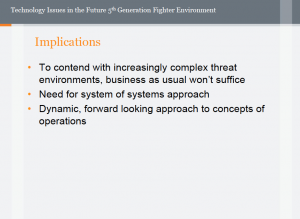2014-03-21 Recently, the Williams Foundation in Australia held a seminar in Canberra on the future of air combat.
In particular, the seminar focused on the impact of fifth generation technologies and was built around a central set of presentations by operators of the impact of fifth generation aircraft on the evolution of combat operations.
RAAF Fighter Pilot Matthew Harper, Lt. Col. Chip Berke and the VMX-22 Commander Mike Orr.
These three operators addressed the question of what the fifth generation experience was all about and how that experience would affect the evolution of the force in the decade ahead.
In the presentation immediately prior to the pilots, Mr. Peter Hunter, from the Australian MOD provided a perspective on fifth generational technology as seen from Australia.
The full presentation can be found on the Williams Foundation website, but some of the key highlights are presented here.
Hunter underscored that within the Pacific region, obviously threats are going up, and threats of the sort that will require an ability to operate rapidly and within difficult combat areas, and the fifth generation is not a nice to have but a sine qua non for operations.
In a later presentation, a senior Royal Australian Air Force (RAAF) officer highlighted the importance of F-35 with Aegis integration to deal with various missile threats, including those involving some nuclear assets.
Hunter viewed fifth generation aircraft a key element of dealing with evolving threats in the region.
Notably, it is the integrated combat systems of the fifth generation aircraft wrapped into a stealth platform, which is the centerpiece of the capability, but the ability to deploy a fleet of such aircraft able to conduct secure communications which was the key enabler of a joint force.
Hunter clearly focused on the no platform fights alone approach in discussing how fifth generation aircraft enabled the overall joint force to prevail.
He placed a central emphasis on the radical changes which data fusion can bring to the combat air fleet.
The data fusion systems of the F-35 are viewed as key enablers for battlespace dominance, a dominance which has already has seen as one in a Red Flag exercise commented that his plane was “destroyed” by an F-22 that “we never saw, never knew was there, and we had no idea where the strike came from that destroyed us.”
A key emphasis throughout was that true fifth generation aircraft is not about a sleek flying machine: it is about integrated combat systems, data fusion and the ability to share and push out the data which allows for information dominance.
He started and ended with a core message: it is not just about technology; it is about mastering the cultural revolution associated with fifth generation technology.
“Success will be dependent upon how innovative we are in leveraging the technology of the fifth generation aircraft and their combat systems as upon the performance of the technology itself.”
He then added “the RAAF has several core competencies, which such allow us to master the new technologies. We need to build upon our world class operational skills and our adaptive, high quality people and training.”
Just having the equipment is not enough. He highlighted this point by talking about aircraft carriers.
“You can buy an aircraft carriers but this does not mean that this will be an effective combat system. This requires many skill sets, training, history and operational skills beyond simply building or buying a platform.”
For a 2011 article on the F-35 and culture change see the following:
http://www.defensenews.com/article/20110221/DEFFEAT05/102210314/Embrace-Air-Power-Revolution




